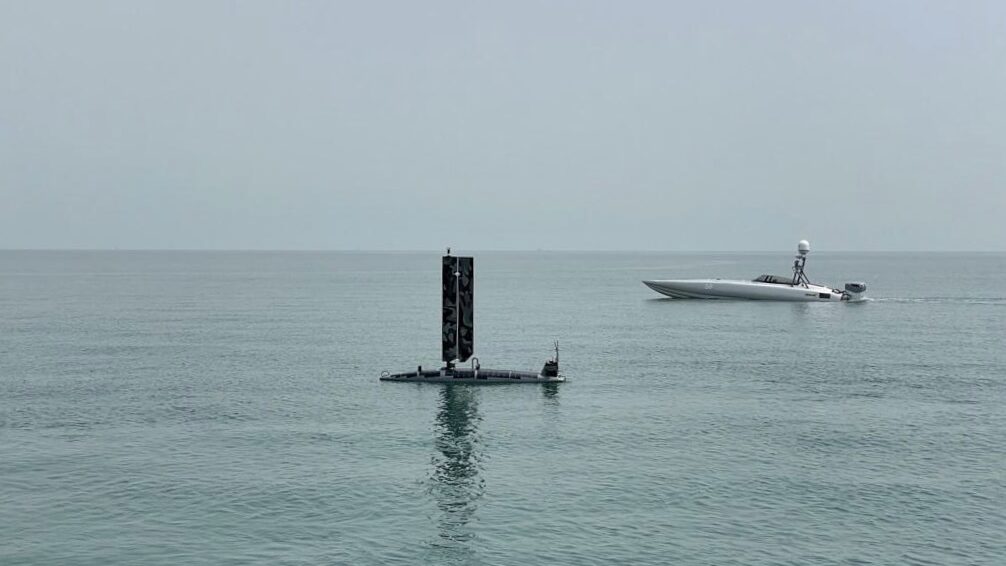A Triton unmanned surface vessel (USV), left, and a Devil Ray T-38 USV operate in the Red Sea, Aug. 19. U.S. 5th Fleet is rapidly integrating new unmanned systems and artificial intelligence into U.S. naval operations across the Middle East to enhance vigilance of the surrounding seas. (U.S. Navy photo by Lt. Cmdr. Ray Miller IV)
WASHINGTON — The way Ukraine has successfully used small, unmanned vehicles to force the dominant Russian navy away from its shores is an “arbiter of things in the future” for naval warfare, the top uniformed officer in NATO said recently — a notable statement, and one that is gaining traction among naval observers.
“It’s quite a thing to watch a country that has virtually no navy [Ukraine] defeat one of the biggest navies [Russia] in the world,” Army Gen. Christopher Cavoli, NATO Supreme Allied Commander and the head of US European Command, said last month in Paris during the Eurosatory conference. “The Ukrainians have successfully pushed the [Russian] Black Sea [Fleet] out of operating west of the southern tip of Crimea. That’s a remarkable thing. And they’ve done it [predominantly] with completely unmanned systems.”
“I can’t quite say the same thing about aerial warfare,” Cavoli added. “But the maritime warfare has been very, very impressive… There seems to be a big role for unmanned maritime systems into the future. I think that’s [going to] be quite disruptive. I’m not as sure about aerial drones.”
A senior US defense official told reporters earlier this year it’s the Pentagon’s assessment that Ukrainian forces — with almost no conventional warships of their own — have sunk, destroyed, or damaged at least 20 medium to large Russian Federation Navy vessels and one Russian-flagged tanker in the Black Sea.
Cavoli’s emphasis on unmanned naval systems is being reflected in Europe, as well as in discussions within NATO.
“I think, Gen. Cavoli is very much on top of that, and I fully agree with him,” Vice Adm. Jonas Haggren, Swedish military representative to NATO, recently told Breaking Defense when asked about Cavoli’s remarks. “There is, of course, a lot of focus on what’s happening in the land domain. That’s the dominant part of the war, of course — but we miss out a little bit of what has happened and what type of capabilities you see that have been used in the maritime domain in Ukraine.”
Haggren said the Ukrainians’ use of unmanned systems in a relatively confined body of water like the Black Sea could be applied to places such as the Baltics, where Sweden and its neighbors are also constantly monitoring Russian naval activities — and where, with the addition of Sweden and Finland to NATO, Russia has to be wary of attacks from multiple angles.
Samuel Bendett, an adjunct senior fellow at the Center for a New American Security, said that the sort of kamikaze attacks that both the Houthis and the Ukrainians have begun using regularly were once only employed “sparingly.”
“What we have now in Ukraine is a systematic and regular development and modernization of multiple maritime USVs and they basically went from just being kamikaze boats to now fulfilling [intelligence, surveillance and reconnaissance] roles, possible mine-laying roles, they are armed with surface-to-air missiles and include surface-to-surface missiles,” he said.
“They’re assuming the roles of naval vessels or roles similar to larger naval vessels,” he continued.
Cavoli’s remarks in many ways reflect the renewed amounts of attention not only each of the US military services are individually paying to unmanned systems, but the Pentagon as a whole, under the Replicator initiative developed by Deputy Defense Secretary Kathleen Hicks.
Unmanned maritime systems like the ones the Ukrainians have used in the Black Sea and ones Cavoli’s counterparts in US Central Command are defending against being used by the Houthis predominantly fall under the US Navy’s purview.
For its part, the service began a renewed push to more wholly incorporate unmanned systems into its fleet starting in 2020 when major portions of its budget began imagining a variety of new unmanned ships operating alongside traditional warships. While its budgetary efforts have stumbled at times, the service’s overall enthusiasm for embracing unmanned technologies has steadily increased under former Chief of Naval Operations Adm. Michael Gilday as well as his successor Adm. Lisa Franchetti.
Aaron Mehta in Washington and Ashley Roque in Paris contributed to this report.





















Discussion about this post